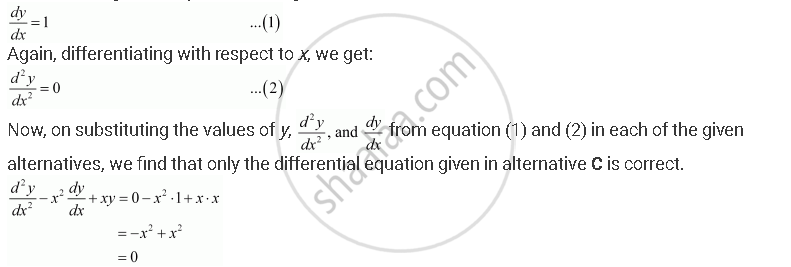Advertisements
Advertisements
Question
Which of the following differential equation has y = x as one of its particular solution?
A. `(d^2y)/(dx^2) - x^2 (dy)/(dx) + xy = x`
B. `(d^2y)/(dx^2) + x dy/dx + xy = x`
C. `(d^2y)/(dx^2) - x^2 dy/dx + xy = 0`
D. `(d^2y)/(dx^2) + x dy/dx + xy = 0`
Solution
The given equation of curve is y = x.
Differentiating with respect to x, we get:

Hence, the correct answer is C.
APPEARS IN
RELATED QUESTIONS
Form the differential equation of the family of circles touching the y-axis at the origin.
Form the differential equation of the family of parabolas having vertex at origin and axis along positive y-axis.
Form the differential equation of the family of hyperbolas having foci on x-axis and centre at origin.
Form the differential equation corresponding to y = emx by eliminating m.
Form the differential equation from the following primitive where constants are arbitrary:
xy = a2
Form the differential equation from the following primitive where constants are arbitrary:
y = ax2 + bx + c
Form the differential equation corresponding to y2 − 2ay + x2 = a2 by eliminating a.
Form the differential equation of the family of curves represented by the equation (a being the parameter):
(x − a)2 + 2y2 = a2
Represent the following families of curves by forming the corresponding differential equations (a, b being parameters):
Represent the following families of curves by forming the corresponding differential equations (a, b being parameters):
y2 = 4a (x − b)
Represent the following families of curves by forming the corresponding differential equations (a, b being parameters):
y = eax
Find one-parameter families of solution curves of the following differential equation:-
\[\frac{dy}{dx} - y = \cos 2x\]
Find one-parameter families of solution curves of the following differential equation:-
\[\left( x \log x \right)\frac{dy}{dx} + y = \log x\]
Find one-parameter families of solution curves of the following differential equation:-
\[\frac{dy}{dx} - \frac{2xy}{1 + x^2} = x^2 + 2\]
Find one-parameter families of solution curves of the following differential equation:-
\[x\frac{dy}{dx} + 2y = x^2 \log x\]
The family of curves in which the sub tangent at any point of a curve is double the abscissae, is given by
Form the differential equation representing the family of curves y = mx, where m is an arbitrary constant.
Find the area of the region bounded by the curves (x -1)2 + y2 = 1 and x2 + y2 = 1, using integration.
Form the differential equation representing the family of curves y = e2x (a + bx), where 'a' and 'b' are arbitrary constants.
Form the differential equation representing the family of curves y = A sin x, by eliminating the arbitrary constant A.
The solution of the differential equation `2x * "dy"/"dx" y` = 3 represents a family of ______.
The differential equation representing the family of curves y = A sinx + B cosx is ______.
Form the differential equation of all circles which pass through origin and whose centres lie on y-axis.
Find the equation of the curve through the point (1, 0) if the slope of the tangent to the curve at any point (x, y) is `(y - 1)/(x^2 + x)`
Family y = Ax + A3 of curves is represented by the differential equation of degree ______.
The curve for which the slope of the tangent at any point is equal to the ratio of the abcissa to the ordinate of the point is ______.
The differential equation of the family of curves y2 = 4a(x + a) is ______.
From the differential equation of the family of circles touching the y-axis at origin
Form the differential equation of the family of hyperbola having foci on x-axis and centre at origin.
